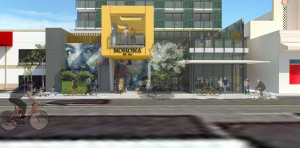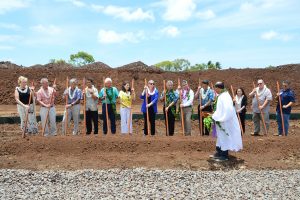Beyond a field of dreams: Making affordables real
Posted on Aug 29, 2018 in Capitol Connection, FeaturedSo what does it take to build more affordable housing for Hawai‘i? By several accounts, it’s taken a governor sitting down with developers, affordable housing advocates and state housing agency leaders — all in one room — and acting on their advice to produce more units faster. From the start of his administration, Governor Ige has asked the same questions: Why aren’t we building more affordable units? What changes can we make to the system to make the process easier and better?
“This governor has done so much he’s not taking credit for,” said Hakim Ouansafi, executive director of the Hawai‘i Public Housing Authority. “He’s made sure departments worked together to save time and money to produce units faster. Before the whole process was frustrating. When the governor got everyone together, he and his staff listened to and acted on suggestions for how to make the process better. With legislators there at the table, they knew the suggestions weren’t political. The ideas were coming from people who can actually develop housing.”
Kevin Carney, EAH vice president and a pioneer in affordable housing, agreed in recent remarks at a Nohona Hale groundbreaking event. “Thanks to the governor and his leadership, we were able to speak directly to state agency staff — with all the islands’ major developers together in one room — to suggest ways to increase production.” The result is an improved system that is producing results, including a streamlined review process and increased funding to help finance more affordable rentals and provide help with infrastructure costs.
Changes produce results: More affordable rental options

An architectural rendering of Nohona Hale, the state’s first micro-unit affordable rental building in Kaka’ako.
The good news for local residents is there are signs of real progress with more new projects coming online and increased state funding to make it economically feasible for developers to build more affordable units. The Ige administration’s goal is 10,000 housing units completed by 2020, with the majority of affordable rentals at 60 percent area median income (AMI) and below. On O‘ahu, that translates to a family of four earning $69,960; $55,980 for a couple; or $49,020 for a single person. “Low-income” translates to 30 percent and below area median income, which equates to $24,510 in Honolulu for a single person or $27,990 for a couple. “Yes, it will take all of us working together to produce the number of affordable units Hawai‘i needs,” said the governor. “But we’re committed to maintaining the momentum, and we’re already seeing results.”
Recent public-private rental partnerships were praised for innovative approaches that show the variety of possibilities in the 30 to 60 percent AMI range. They include:
- Nohona Hale – The state’s first micro-units in Kaka‘ako through a partnership between Bronx Pro Group, Swinerton Builders and non-profit EAH Housing. The 300-square-foot studios are on the rail transit line with 70-square-foot lanais and floor-to-ceiling windows to provide a sense of openness. Completion date: January 2020.
- Keahumoa Place – An affordable Kapolei rental community by the Michaels Organization of 320 one-, two-, and three-bedroom units aimed at families earning 80 percent or less AMI. The two-story garden–style buildings will include a community center, picnic area, tot lot and pet park. Completion date: First phase – late 2019.
- Waipahu Tower – An older rental complex of 62 affordable units renovated by the Ahe Group, preserved to remain affordable for local residents. The refurbishing included new floor, appliances, and PV panels to save about $100,000 in electricity costs.
According to a Honolulu Star-Advertiser analysis, statistics show the governor has secured record amounts for the state’s Rental Housing Revolving Fund since taking office. “During his first three years in office . . . he secured nearly as much funding for the program as has been allocated during its two-decade history,” The same article said, “The pace at which affordable housing projects have been awarded funds has also increased under Ige. Over the past 3 ½ years, 21 projects were awarded funds. This compares with 21 projects awarded during the seven years prior to Ige taking office.”
The path to 22,500 affordable rentals
A special action team has produced a road map for building 22,500 affordable rentals needed statewide by 2026. The report includes an inventory of sites and the units needed by island and household income levels. One of the major recommendations is to contribute $100 million annually for the next 10 years to the state’s Rental Housing Revolving Fund to help developers finance affordable construction.
The Hawai‘i Housing Finance and Development Corp. has provided close to $100 million in rental housing funds in each of the last two years, and developers have already applied for $182 million of the $200 million appropriated by the legislature this year, according to HHFDC director Craig Hirai. “This momentum needs to continue,” he said. “You have to sustain the effort over a period of years.”
